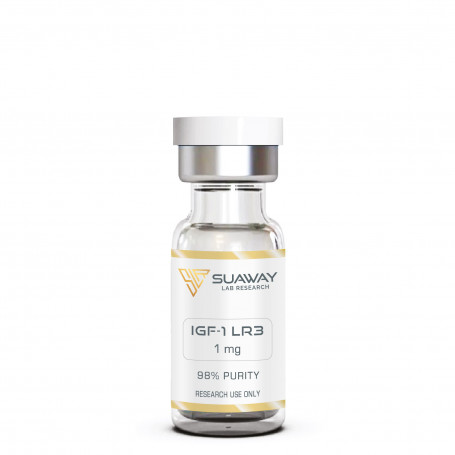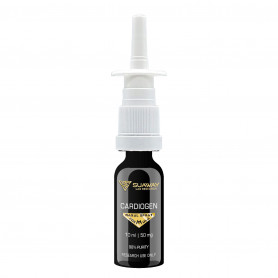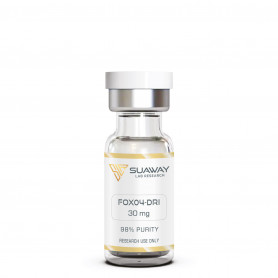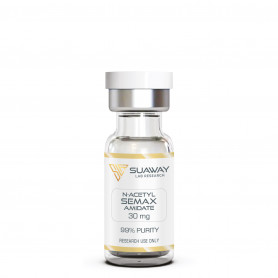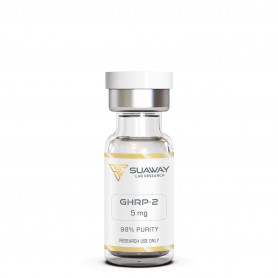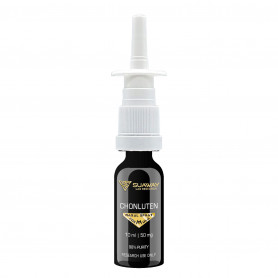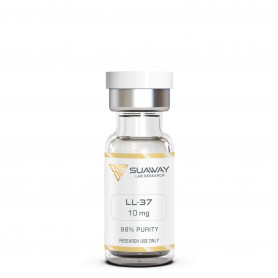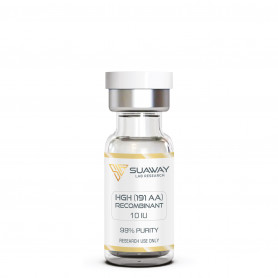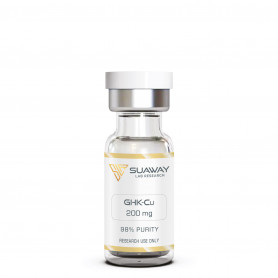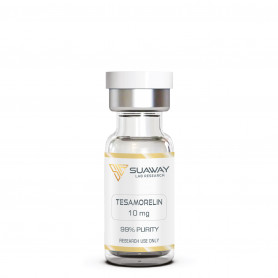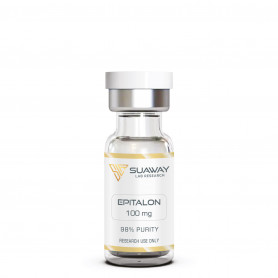IGF-1 LR3 - 1 mg
IGF-1 LR3 greatly boosts muscle mass by inducing a state of muscle hyperplasia. It has been demonstrated that:
- It is a potential treatment of growth hormone IGF-1 deficiency
- Decreases body fat
- Increases metabolism
- Increases bone density
- It is a potential treatment of muscle dystrophy and diabetes
- Contributes to the growth of a healthy, lean muscle mass
Description
STRUCTURE
Sequence: MFPAMPLSSL FVNGPRTLCG AELVDALQFV CGDRGFYFNK PTGYGSSSRR APQTGIVDEC CFRSCDLRRL EMYCAPLKPA KSA
Molecular Formula: C400H625N111O115S9
Molecular Weight: 9117,5 g/mol
CAS: 946870-92-4
Peptide Purity: Greater than 98%.
Other details: No TFA Salt
Storage: Lyophilized peptide must be stored at -20°C and peptide solution at 4°C.
IGF-1 LR3 has low oral and excellent subcutaneous bioavailability.
DESCRITPION
IGF-1 is indeed a polypeptide hormone and its molecular characteristics are comparable to those of insulin. The abbreviation for "insulin-like growth factor" is "IGF." IGF-1 LR3, has been shown in various research studies to have the potential benefit to burn fat, through increased lipolysis, aiding in weight loss, and to build muscle by promoting protein synthesis and muscle recovery.
All IGF-1 derivatives play major roles in cell division, cell growth, and cell-to-cell communication. IGF-1 LR3, although having effects comparable to those of IGF-1, does not bind to IGF-associated protein as robustly as IGF-1 does. IGF-1 LR3 is an alteration of IGF-1 as it contains arginine and an extended amino acid structure at its N-terminal, making it a long peptide composed of 80+ amino acids. Because of this alteration, IGF-1 LR3 has increased half life of up to 20-30 hours versus the normal IGF-1 half-life of 12-15 hours and has three times the potency of IGF-1. What’s more, IGF-1 LR3 has a poor binding affinity towards the IGF-1 receptors. Consequently, the peptide is easily distributed in the body organs in its natural form and results in faster plasma clearance than the normal IGF-1.
IGF1-LR3, much like IGF-1, acts as a powerful stimulant for the division and proliferation of cells. The major effects that it has are on muscle tissue like muscles and bone, it also stimulates cell division in the liver, kidneys, nerves, skin, lungs, and blood tissues. Other tissues that it affects include blood and skin. It is easiest to think of IGF-1 as a hormone that promotes maturation since, in addition to promoting cell proliferation, it also encourages cell differentiation.
IGF1-LR3, in contrast to IGF-1, may be detected in circulation for much longer lengths of time. IGF1-LR3 is a very powerful molecule due to its possessing this feature. When compared to an equivalent dosage of IGF-1, the amount of cell activation produced by a dosage of IGF1-LR3 is roughly three times higher. It is important to keep in mind that IGF1-LR3 and all other IGF-1 derivatives do not encourage the expansion of cells (hypertrophy), but rather the division and proliferation of cells (hyperplasia). IGF1-LR3, for example, does not induce muscle cells to get much bigger, but it does promote a rise in the overall number of muscle cells.
There is a 2005 study where the effects of rhIGF-1 on patients suffering from IGF-1 deficiency and growth disorders were studied. RhIGF-1 is the recombinant form of insulin-like growth factor 1, and has successfully been used in the treatment of GH insensitivity. RhIGF-1 is a synthetic form of IGF-1 that is exogenously administered to overcome the GH deficiency. 45 participants with natural short stature were enrolled in this controlled study, where rhIGF-1 was administered at a dose of 60 mcg/kg once daily to all the participants via subcutaneous route. The doses were then adjusted at the later half of the study based on the participant’s age and gender, up to a maximum given dose of 240 mcg/kg per day. The heights of all participants were measured before and after the study. It was noticed that there was an average increase in height by 7cm per year in all participants treated with rhIGF-1. Hence, this study demonstrates that IGF-1 analogs have a positive effect in treating growth deficiency. The same can potentially be said for IGF-1 LR3, making it a potential agent to be used in the growth hormone deficiency in humans.
IGF1-LR3, by binding both the IGF-1R receptors as well as the insulin receptor, stimulates the metabolism of fat in a way that is roundabout and indirect. The absorption of glucose from the blood via muscle, neuron, and liver cells is increased as a result of these processes. This leads to an overall reduction in blood sugar levels, which in turn stimulates adipose tissue and the liver to begin the process of breaking down glycogen or triglycerides. Overall, this leads to a reduction in the amount of adipose tissue that is produced. It should not come as a surprise that IGF1-LR3 lowers insulin levels and the need for insulin injections in diabetics because of its involvement in lowering blood sugar levels. In the majority of instances, this corresponds to a 10% reduction in the amount of insulin that is expected to sustain the same levels of blood sugar.
People who suffer from muscle loss as a result of extended immobility, as well as those who have illnesses like Duchenne muscular dystrophy (DMD), might benefit from the capacity to inhibit the activity of myostatin. When these conditions exist, blocking this naturally occurring enzyme may help reduce the rate of muscle breakdown, preserving strength, and avoiding morbidity.
In mice models of Duchenne muscular dystrophy (DMD), researchers have shown that IGF1-LR3 as well as other IGF-1 analogs can inhibit the deleterious effects of myostatin, therefore protecting muscle cells and halting the process of apoptosis.
Myostatin, also known as growth differentiation factor 8, is a muscle protein that largely slows the proliferation and differentiation of muscle cells. Even though this function is essential for avoiding uncontrolled hypertrophy and ensuring appropriate recovery after damage, there are situations in which suppressing myostatin might be beneficial.
IGF1-LR3, which has a very long half-life, is very efficient in inhibiting the effects of myostatin. It seems to do this by stimulating a protein called MyoD, which is found in muscle. MyoD is indeed the protein that is essential for muscle growth. It is generally triggered by activity (for example, lifting weights), but it may also be activated by injury to the tissue.
IGF1-LR3 is a protective molecule against cell damage as well as the effects of aging since it encourages the repair and maintenance of tissues throughout the body. This makes it an anti-aging molecule. According to the findings of recent research, the injection of IGF1-LR3 may be a viable option for effectively reversing the consequences of cellular aging.
REFERENCES
"Growth hormone, athletic performance, and aging" [Harvard Health Publishing]
S. Yakar et al., "40 YEARS OF IGF1: Insulin-like growth factors: actions on the skeleton" [Journal of Molecular Endocrinology]
"Recombinant Human Insulin-Like Growth Factor (rhIGF-1) Treatment of Short Stature Associated With IGF-1 Deficiency" [ClinicalTrials]
S. Gehmert et al., "Adipose tissue-derived stem cell secreted IGF-1 protects myoblasts from the negative effect of myostatin" [PubMed]
By Mayo Clinic Staff "Human growth hormone (HGH): Does it slow aging?" [Mayo Clinic]
F.M. Tomas et al., "Insulin-like growth factor-I (IGF-I) and especially IGF-I variants are anabolic in dexamethasone-treated rats" [PMC]
L.J. Anderson et al., "Use of Growth Hormone, IGF-I, and Insulin for Anabolic Purpose: Pharmacological Basis, Methods of Detection, and Adverse Effects" [PMC]
W.E. Sonntag et al., "Diverse Roles of Growth Hormone and Insulin-Like Growth Factor-1 in Mammalian Aging: Progress and Controversies" [The Journal of Gerontology]
S. Mohan et al., "IGF-binding proteins are multifunctional and act via IGF-dependent and -independent mechanisms" [PubMed]
B. Assefa et al., "Insulin-Like Growth Factor (IGF) Binding Protein-2, Independently of IGF-1, Induces GLUT-4 Translocation and Glucose Uptake in 3T3-L1 Adipocytes" [PMC]
DISCLAIMER
This product is intendend for lab research and development use only. These studies are performed outside of the body. This product is not medicines or drugs and has not been approved by the FDA or EMA to prevent, treat or cure any medical condition, ailment or disease. Bodily introduction of any kind into humans or animals is strictly forbidden by law. This product should only be handled by licensed, qualified professionals.
All product information provided on this website is for informational and educational purposes only.

